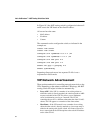
C H A P T E R 18 Server Load Balancing (SLB)
349
• The virtual port number
Once you know which virtual server options are useful in your
network, you can:
• Define standard virtual servers
• Define wildcard virtual servers
Each virtual server maps to a single pool, which can be a group of
content servers, firewalls, routers, or cache servers.
You can configure two different types of virtual servers:
• Standard virtual servers
A standard virtual server represents a site, such as a Web site or
an FTP site, and it provides load balancing for content servers.
The virtual server IP address should be the same IP address that
you register with the DNS (domain name system) for the site
that the virtual server represents.
• Wildcard virtual servers
A wildcard virtual server load balances transparent network
devices such as firewalls, routers, or cache servers. Wildcard
virtual servers use a special wildcard IP address (0.0.0.0), and
you can use them only if Transparent mode is activated.
For cache server applications, use flow redirection.
A virtual server is identified by a virtual IP address. To create a
virtual server, use this command:
create slb vip <vipname> pool <poolname> mode
[transparent | translation | port-translation]
<ipaddress>{-<upper_ipaddress>}: <L4Port> {unit
<number>}
Forwarding Modes
The 480T routing switch supports these SLB forwarding modes:
• Transparent
• Translational
• Port Translation
• GoGo


















